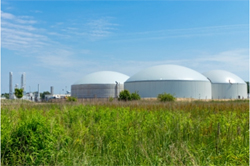Activated carbon is commonly used for the purification or separation of gases.
Typical examples are:
- Biogas:
The gas comes from the anaerobic digestion of biomass, usually through natural processes involving bacteria. These processes lead to the production of large amounts of carbon dioxide and methane, together with some other organic gases, and also impurities.
The main impurity found is hydrogen sulphide, which, as an acid gas, can cause serious problems through corrosion In some cases other impurities such as siloxanes are also found. Both of these can be removed by use of suitable activated carbons.

Digesters at a biogas plant
- Carbon Dioxide Purification:
CO2 used by food industry (ex. to produce sodas) need to be free of odorous hydrocarbons and sulphur compounds. CO2 gas obtained during various fermentation processes can be treated with activated carbon to meet required purity.
- Separation by Pressure Swing Adsorption (PSA):
Gas separation is accomplished by sequences of adsorption at high pressure followed by desorption at low pressure. Allows production of pure gases as hydrogen , nitrogen, ...
- Compressed Gas:
In order to protect compressors' parts, and also as an aid to efficiency, activated carbon is used to remove traces of lubrication oil from air streams.

- Mercury Removal from natural gas:
A large amount of natural gas reserves contain trace concentrations of mercury. Mercury removal is particularly important in the production of Liquefied Natural Gas (LNG) as the mercury can lead to corrosion of aluminium heat exchangers used in this process.
- Gas Desulphurisation:
Several gases are desulphurised using activated carbon, to prevent corrosion of pipelines and as protection for catalysts. Examples are the desulphurisation of natural gas, biogas, hydrogen and various other pure gases.
